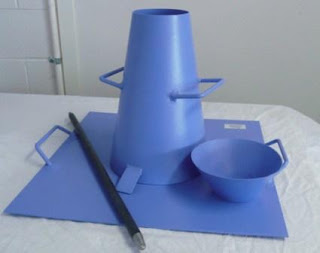Concrete - Workability - Slump test
AIM
To determine the workability of fresh concrete by slump test as per
IS: 1199 - 1959
APPARATUS
REPORTING OF RESULTS
The slump measured should be recorded in mm of subsidence of the specimen during the test. Any slump specimen, which collapses or shears off laterally gives incorrect result and if this occurs, the test should be repeated with another sample. If, in the repeat test also, the specimen shears, the slump should be measured and the fact that the specimen sheared, should be recorded.
To determine the workability of fresh concrete by slump test as per
IS: 1199 - 1959
APPARATUS
 |
| SLUMP CONE |
- Slump cone
- Tamping rod
PROCEDURE
- The internal surface of the mould is thoroughly cleaned and applied with a light coat of oil.
- The mould is placed on a smooth, horizontal, rigid and nonabsorbent surface.
- The mould is then filled in four layers with freshly mixed concrete, each approximately to one fourth of the height of the mould.
- Each layer is tamped 25 times by the rounded end of the tamping rod (strokes are distributed evenly over the crosssection).
- After the top layer is rodded, the concrete is struck off the level with a trowel.
- The mould is removed from the concrete immediately by raising it slowly in the vertical direction.
- The difference in level between the height of the mould and that of the highest point of the subsided concrete is measured.
- This difference in height in mm is the slump of the concrete.
REPORTING OF RESULTS
The slump measured should be recorded in mm of subsidence of the specimen during the test. Any slump specimen, which collapses or shears off laterally gives incorrect result and if this occurs, the test should be repeated with another sample. If, in the repeat test also, the specimen shears, the slump should be measured and the fact that the specimen sheared, should be recorded.




Comments
Post a Comment
Please do not enter any spam in the comment box.